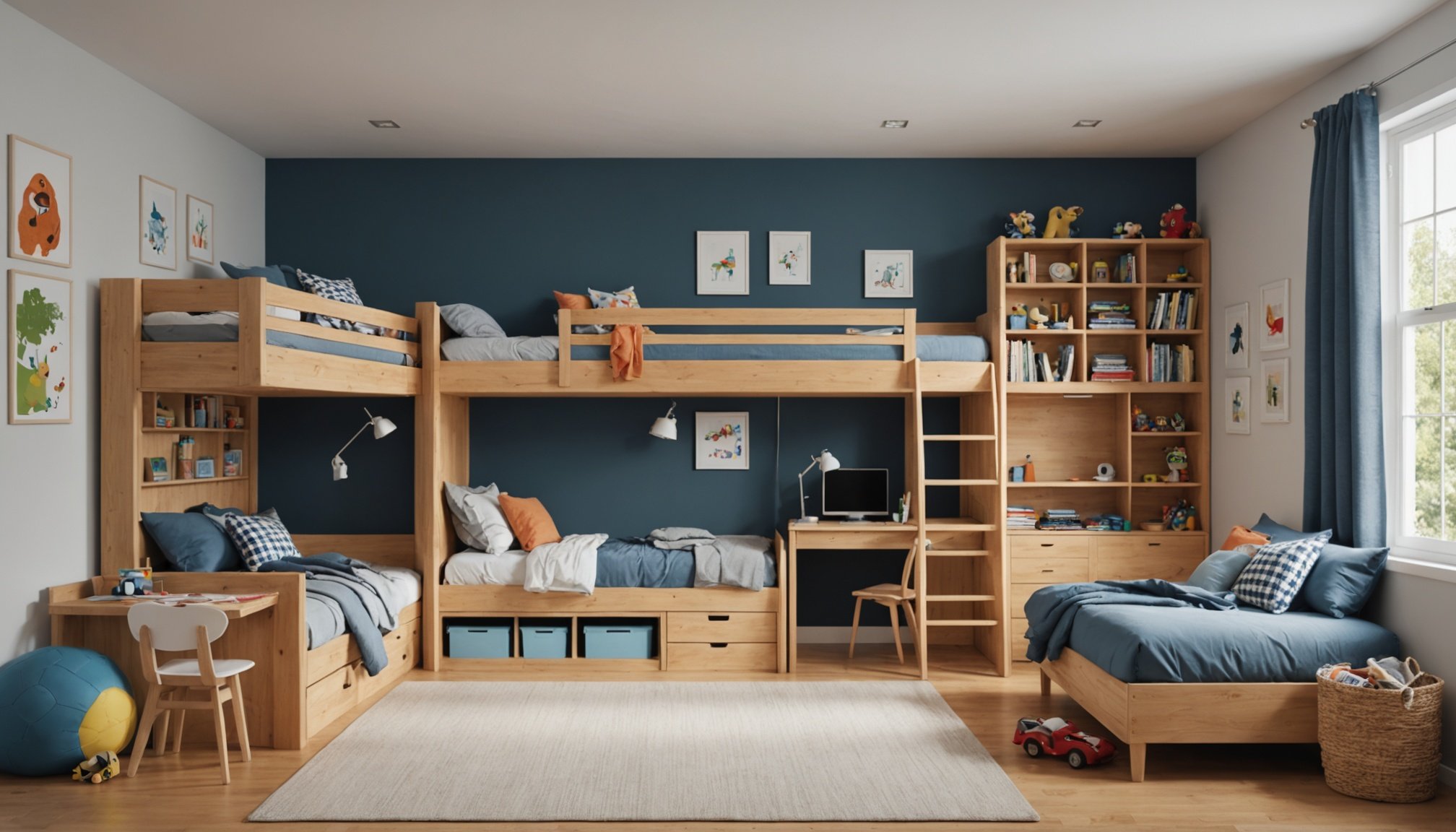Understanding Shared Bedroom Dynamics
Navigating the complexity of shared bedroom strategies in a family context requires a nuanced understanding of family dynamics and children’s needs. Recognizing individual personalities and preferences is foundational to creating a harmonious shared space. Each child may have distinct tastes, and acknowledging these can help balance their need for privacy with a sense of togetherness among siblings.
Privacy, though challenging to maintain in a shared environment, can be addressed through creative solutions. Curtains or personal screens around sleeping areas offer a semblance of privacy, giving each child a personal retreat.
In parallel : Unlocking Vertical Potential: Innovative Ideas for Multi-Level Townhouse Living
Age differences further influence how children adapt to sharing a bedroom. Younger siblings might require more supervision and may value proximity to their siblings for reassurance, while older children might crave independence. Addressing these age-related needs can prevent potential conflicts and help maintain a peaceful coexistence.
In essence, fostering a respectful and communicative environment is crucial. Encouraging children to express their preferences and find compromises ensures everyone’s needs are met, turning a shared bedroom into a space where siblings grow together in harmony.
In parallel : Thriving Indoor Tropical Gardens in the UK: Expert Tips for Creating a Lush Green Paradise All Year Round
Space-Saving Furniture Solutions
Shared bedrooms demand creative, space-saving furniture to optimize limited areas effectively. Multifunctional designs provide practical solutions, allowing space to transform as needed without overcrowding. When choosing kids’ furniture, versatility is key.
Bunk Beds with Storage
Bunk beds double up on functionality, utilizing vertical space seamlessly. These beds leave floor room available while integrating creative storage solutions. Look for models with built-in drawers or shelves to keep children’s items organized. Prioritizing safe and sturdy options is essential to ensure durability and child safety.
Convertible Furniture
Convertible sofas that transform into beds serve dual purposes—ideal for playdates or sleepovers, offering flexibility. For study or playtime, foldable desks and tables maximize the utility without permanent spatial commitment. Selecting furniture that grows with children ensures longevity; beds or desks with adjustable heights adapt to changing needs.
Under-Bed Storage Ideas
The space under beds offers untapped potential. Utilize it with bins or drawers for shoes, toys, or clothes, promoting room tidiness. Bed risers can create even more storage scope, while easy-access solutions ensure items remain accessible to children. This approach keeps the room both spacious and organized without compromising on functionality.
Organizational Strategies
Optimizing shared bedroom spaces relies heavily on effective room organization and consistent decluttering tips. A clutter-free environment encourages not only physical space but mental clarity as well. Begin with clear bins, which simplify the process of sorting and storing children’s belongings. Label each bin to enhance accessibility. This organizational strategy allows children to locate and replace their toys, clothes, and other items easily.
Implementing a chore chart can significantly improve personal space management. Assign age-appropriate tasks that teach children the importance of organizing their belongings. This instills a sense of responsibility and pride in maintaining their shared environment.
When organizing shared bedrooms, adapt systems as children grow. Regularly reviewing and updating organization solutions is crucial. As children’s interests and needs evolve, so should their storage systems. Involving children in these updates encourages independence and creativity, making them an integral part of maintaining their shared space.
Use vertical storage solutions, such as shelves or hanging racks, to maximize floor space. Doing so ensures that the room remains visually appealing while accommodating all necessary items. Prioritize easy-access storage, enabling children to engage independently with their surroundings and fostering a sense of ownership over their shared space.
Aesthetic and Functional Design
Implementing effective bedroom design requires balancing aesthetics with functionality, especially in shared spaces. An appealing environment can foster a sense of ownership and comfort for children. Incorporating personal preferences into shared spaces while maintaining harmony is crucial.
Color Schemes that Appeal to Kids
Choosing the right color schemes can enhance mood and creativity. Opt for calming shades like soft blues or greens, creating a peaceful atmosphere. Allowing children to select colors that reflect their interests can ensure a sense of personal connection. This personalised choice not only livens up shared spaces but also makes them more welcoming.
The Role of Lighting
Lighting plays a pivotal role in functionality and ambiance. Prioritize natural light to make the room feel more open and warm. For study areas, well-placed task lighting can improve focus, while night lights provide comfort and safety during nighttime. Proper lighting can impact mood and productivity, supporting varied activities in the room.
Creating Zones within the Room
Defining personal spaces can minimise conflicts and boost autonomy. Use rugs, distinct furniture placement, or even colour contrasts to create zones for individual and communal activities. Designing these partitions helps maintain organization and provides children with both personal and shared spaces to enjoy.
DIY Projects for Added Personalization
Involving children in DIY projects not only enhances creativity but fosters a sense of ownership over their shared space. Personal touches can transform a room and reflect the dynamic of your family.
Crafting Personalized Storage Solutions
Creating custom shelving is a practical way to personalise storage. Begin by gathering materials such as wooden crates or repurposed boxes, allowing children to sand and paint these for unique flair. Involvement in crafting empowers kids, making organization both fun and engaging.
Benefits of involving children include building skills and enhancing their responsibility toward their environment. Furthermore, these projects can produce functional outcomes, like personalised drawer tags or wall-mounted storage for frequently used items.
Wall Art and Decor Ideas
Affordable wall decor can be child-friendly and imaginative. Consider using family photographs, children’s own artwork, or decals to add vibrancy. Encourage kids to create seasonal art, making it an ongoing, fun family activity.
Building a Collaborative Family Project
Select a project that involves all family members, such as a mural or themed decor. This not only unifies the space but strengthens family bonds through collaboration. Celebrate its completion with a family event, positively reinforcing teamwork and the joy of shared accomplishments.
Success Stories and Testimonials
Real-life stories provide valuable insights and motivation for those navigating the complexities of shared bedroom spaces. Families who’ve implemented effective shared bedroom strategies often report a remarkable transformation in both their physical environment and family dynamics. Prioritizing space-saving furniture and personalized design solutions has led to improved functionality and satisfaction.
An inspiring example is the Johnson family, who optimised their shared bedrooms by emphasizing multifunctional design and smart storage solutions. By introducing bunk beds with integrated storage, they maximized vertical space. Installing a versatile desk that adapts as the children grow exemplified thoughtful planning, ensuring long-term utility and reduced clutter.
Personal experiences highlight the role of creativity in overcoming challenges. In the Martinez household, instating a simple chore chart significantly improved organization, fostering a sense of responsibility among siblings. This encouraged them to maintain their personal zones and manage their children’s belongings efficiently.
Testimonials frequently mention the unifying effect of family involvement in DIY projects and decor decisions. By participating in these projects, families build deeper connections. Children feel a sense of accomplishment and ownership over their shared space, enhancing both their well-being and the room’s atmosphere.





